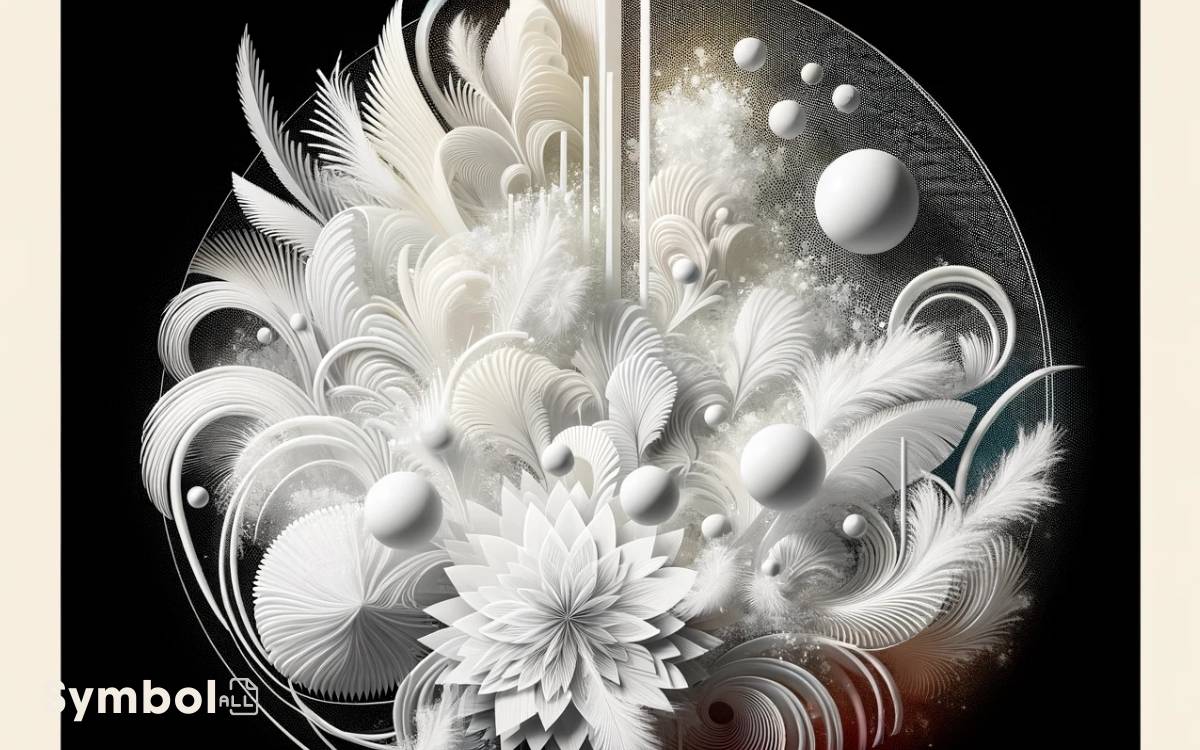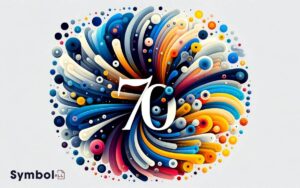What Does the Color White Symbolize in the Great Gatsby
In “The Great Gatsby,” the color white symbolizes an illusion of purity and innocence that masks a deeper moral decay.
You see Daisy Buchanan, oozing with an ethereal aura in white, embodying this deceptive purity while her character harbors a dual nature.
White also critiques the hollow pursuit of the American Dream, reflecting the false promise of innocence and the unattainable purity in Gatsby’s love for Daisy. It challenges you to look beyond appearances to see the corruption and moral ambiguity that lie beneath.
As you explore further, you’ll uncover how Fitzgerald uses white to dissect the complexities of human nature and societal values.

Key Takeaway
The Illusion of Purity
In F. Scott Fitzgerald’s The Great Gatsby, the recurrent use of white masks a deceptive facade of purity, subtly critiquing the moral bankruptcy of the era’s elite.
You’ll notice this symbolism through the lavish parties at Gatsby’s mansion, where the color white signifies a surface-level innocence that belies the corruption underneath.
It’s not just in the grandeur of Gatsby’s parties but also in the seemingly pristine settings that Fitzgerald seeds this critique. The color white becomes a tool, shedding light on the hollowness of the upper class’s virtue.
This choice challenges you to see beyond appearances, recognizing the complexities and contradictions that define human nature and society. It’s a call to question the real value of surface purity when it cloaks deep-seated moral decay.
Daisy Buchanans Ethereal Aura
Daisy Buchanan’s ethereal aura, frequently cloaked in white, subtly embodies the novel’s exploration of purity and moral ambiguity, inviting readers to investigate further into her complex character.
This attire isn’t merely a fashion statement; it serves as a critical narrative device, offering insights into Daisy’s persona and the broader thematic concerns of the narrative.
Consider these aspects:
- Visual Symbolism: Daisy’s white dresses mirror her outward display of innocence and simplicity, contrasting sharply with her inner turmoil and the complexities of her desires.
- Character Depth: Her choice of white encapsulates the duality within her character, suggesting purity while hinting at a lack of substance or depth.
- Narrative Function: The color serves as a narrative cue, guiding readers through the maze of social critique embedded within the text.
Analyzing Daisy’s white-enveloped appearance reveals layers to her character and enriches the thematic fabric of the novel.
The False Promise of Innocence
As you explore the symbolism of white in ‘The Great Gatsby‘, consider how Daisy’s perceived innocence, cloaked in white, belies her true nature, revealing a deceptive purity.
This false facade mirrors the elusive American Dream, promising fulfillment but delivering disillusionment.
Gatsby’s pursuit of Daisy, driven by his ill-fated love, underscores the tragic reality that not all that glitters is gold, especially in a world veiled in the false promise of innocence.
Daisys Deceptive Purity
Through the lens of F. Scott Fitzgerald’s The Great Gatsby, the character of Daisy Buchanan embodies the deceptive purity of white, masking a complex web of innocence unfulfilled and moral ambiguity.
This false promise of innocence is critical to understanding her character’s impact on the narrative.
- Superficial Innocence: Daisy’s association with white suggests purity and innocence at first glance, yet her actions reveal a self-serving nature hidden beneath the veneer.
- Moral Ambiguity: Her character oscillates between vulnerability and manipulation, challenging the binary of purity versus corruption.
- Unfulfilled Promises: Daisy’s portrayal in white underscores the thematic element of unfulfilled dreams and promises, mirroring the disillusionment experienced by other characters.
This analysis peels back the layers of Daisy’s character, revealing how white symbolizes not just innocence lost but the complexity of human nature itself.
Elusive American Dream
In The Great Gatsby, the American Dream‘s illusory nature is epitomized by the characters’ relentless pursuit of a purity and innocence that, ultimately, proves to be a mirage.
This chase is symbolized by the extensive use of white, a color traditionally associated with these qualities.
Yet, as you dig deeper, it becomes evident that this pursuit is fraught with contradictions and moral ambiguities, rendering the sought-after innocence unattainable.
The characters’ fixation on this idealized purity mirrors the broader societal obsession with the American Dream a concept promising equal opportunity and success for all, regardless of past sins or societal standing.
However, Fitzgerald skillfully reveals this promise as a deceptive facade, suggesting that such purity and success are, in fact, unachievable, thereby critiquing the very foundation of the American ethos.
Gatsbys Ill-fated Love
Gatsby’s passionate quest for Daisy Buchanan embodies the false promise of innocence, revealing the inherent flaws in his pursuit of the American Dream.
This ill-fated love isn’t just about unrequited affection; it’s a mirror reflecting the broader disillusionment with the American Dream itself.
- The Illusion of Purity: Daisy, often associated with white, symbolizes an unattainable purity and innocence that Gatsby chases, mistaking material success for spiritual fulfillment.
- The Reality of Corruption: Beneath the veneer of innocence, Daisy’s choices are influenced by societal expectations and material comforts, showcasing the corruption that taints the dream.
- The Inevitability of Despair: Gatsby’s failure to reclaim Daisy’s love ultimately signifies the impossibility of returning to an idealized past or attaining an untainted dream.
Gatsbys Elusive Dream
You’ll find Gatsby’s pursuit encapsulated in dreams’ fragile nature, the hollow core of wealth, and Daisy’s symbolic role, illustrating a profound critique of the American Dream.
Fitzgerald uses these elements to show you how Gatsby’s aspirations, though seemingly pure, are built on unstable foundations.
This exploration reveals the inherent emptiness in Gatsby’s quest, underscoring the novel’s thematic concerns with disillusionment and the pursuit of an unattainable ideal.
Dreams Fragile Nature
Though Jay Gatsby’s dream of rekindling his romance with Daisy Buchanan glimmers with hope, it ultimately showcases the delicate nature of aspirations, highlighting how easily they can shatter against the harsh realities of life.
In The Great Gatsby, Fitzgerald uses Gatsby’s pursuit to underscore several truths about dreams:
- Time’s Irreversibility: Gatsby’s efforts to recreate the past underscore the impossibility of recapturing lost time.
- The Role of Vital: Unforeseen events, like Daisy’s reaction and societal pressures, play a vital role in the fruition or failure of dreams.
- Internal Conflicts: Gatsby’s internal struggle between his idealized vision of Daisy and her reality illustrates how personal conflicts can undermine even the most fervent dreams.
This narrative serves as a poignant reminder of dreams’ inherent fragility, urging readers to tread the fine line between aspiration and delusion with caution.
Wealths Hollow Core
While the fragility of dreams reveals much about human aspiration, understanding the emptiness at the heart of Gatsby’s wealth offers deeper insight into the novel’s critique of the American Dream.
Gatsby’s mansion and lavish parties symbolize not just a quest for love but also an attempt to validate his existence through material success.
However, you’ll notice that these outward signs of wealth are but a façade masking a profound emptiness.
Gatsby’s dream, tied to wealth as a means to win Daisy’s love, ultimately underscores the hollowness at the core of the American Dream. It suggests that the pursuit of wealth for status or love is an elusive quest, leaving one more alienated than fulfilled.
This narrative thread weaves a cautionary tale about the dangers of conflating material wealth with happiness or fulfillment.
Daisys Symbolic Role
Daisy Buchanan embodies Gatsby’s unattainable dream, serving as a poignant symbol of his perpetual quest for an idealized love that remains forever out of reach.
Her role in the narrative isn’t merely to serve as a love interest but to represent:
- The unachievable nature of the American Dream, highlighting its illusory qualities.
- A critique of societal values, where materialism and status eclipse genuine emotion and connection.
- The destructive power of idealization, showcasing how Gatsby’s obsession leads to his downfall.
Through Daisy, you’re invited to ponder the cost of chasing a dream that’s built on a foundation of illusion rather than reality.
Her symbolic role in The Great Gatsby offers a critical lens through which to view the novel’s themes of love, ambition, and the elusive nature of the American Dream.
Symbols of Wealth and Status
In F. Scott Fitzgerald’s ‘The Great Gatsby,’ white serves as a multifaceted symbol of wealth and status, intricately woven into the fabric of the narrative to reveal the complex interplay between appearance and reality in the American Dream.
You’ll observe that characters draped in white or those inhabiting white spaces are often perched atop the social ladder, embodying an aura of purity and innocence that masks their moral bankruptcy.
This deliberate choice underscores the emptiness that often accompanies material excess. Fitzgerald uses white to critique the superficial allure of the upper class, suggesting that beneath the pristine surface lies a corrupt, disenchanted core.
Your understanding deepens as you recognize how white not only symbolizes wealth and status but also acts as a critical commentary on the hollowness of such pursuits.
The Façade of Social Prestige
You’ll notice that Fitzgerald’s use of white not only symbolizes a superficial purity but also masks the characters’ moral decay and the hollow core of their wealth.
This façade of social prestige suggests that beneath the veneer of sophistication and nobility often lies a darker reality.
It’s this contrast between appearance and truth that underscores the novel’s critique of the American Dream.
Illusion of Purity
White often symbolizes an illusion of purity, cleverly masking the underlying corruption and moral decay within the elite social circles of ‘The Great Gatsby’.
This portrayal isn’t just a backdrop but a critical narrative device that F. Scott Fitzgerald employs to critique the era’s socio-economic disparities.
- Visual Deception: Characters draped in white give off an aura of innocence and virtue, misleading others about their true natures.
- Contrast to Reality: The stark white settings juxtapose the moral ambiguity and ethical compromise, highlighting the dissonance.
- Ephemeral Innocence: White signifies the transient purity of dreams and desires that are ultimately tainted by the characters’ actions.
This strategic use of white unravels the layers of pretense, urging you to question the authenticity of the superficial purity presented by the upper echelons.
Wealths Hollow Core
Beneath the glittering façade of social prestige, Fitzgerald exposes the hollow core of wealth, revealing how it distorts values and erodes true human connections.
You’ll find that in ‘The Great Gatsby,’ white isn’t merely a symbol of purity; it cunningly masks the emptiness that pervades the lives of the novel’s affluent characters. The color yellow symbolism in The Great Gatsby further amplifies this disparity, often representing the false promise of wealth and success. While white suggests an outward veneer of perfection, yellow exposes the corruption and moral decay lurking beneath the surface. Together, these colors wield a sharp critique of the hollow pursuits that define Gatsby’s world.
This color, emblematic of wealth’s surface allure, simultaneously signifies the moral bankruptcy and emotional void at its heart.
Gatsby’s lavish parties, cloaked in opulence, are stark illustrations of how material excess can substitute for genuine fulfillment.
Fitzgerald deftly uses white to critique the era’s obsession with status, suggesting that beneath the luminous exterior lies a profound desolation.
Consequently, white becomes a powerful tool in unraveling the illusion that wealth equates to happiness or meaning.
White and the American Dream
Scott Fitzgerald’s use of white symbolizes the purity and allure of the American Dream, yet subtly critiques its unattainability for the novel’s characters. This color, often associated with innocence, masks the deeper, unreachable aspirations they chase.
Consider the following:
- Gatsby’s White Mansion: A symbol of his success, yet a monument to his unfulfilled desires and isolation.
- Daisy’s White Dresses: Representing the purity Gatsby attributes to her, contrasting with her unreachable nature and the disillusionment that follows.
- The White City: A metaphor for the American Dream itself, shining from a distance, but up close, it’s fraught with complexities and disillusionment.
Through these elements, Fitzgerald weaves a narrative that questions the very foundation of the American Dream, suggesting its pristine appearance often hides a more complicated reality.
Moral Ambiguity and Corruption
In ‘The Great Gatsby,’ Fitzgerald masterfully exposes the moral ambiguity and corruption lurking behind the opulent facade of the Roaring Twenties, challenging readers to question the integrity of its characters and the society they inhabit.
| Character | Act of Corruption | Impact |
|---|---|---|
| Daisy | Hit-and-run | Moral decline |
| Tom | Affairs | Social decay |
| Gatsby | Illegal business | Ethical ambiguity |
| Jordan | Cheating in golf | Personal deceit |
| Myrtle | Affair with Tom | Moral compromise |
Fitzgerald doesn’t just tell you about the era’s grandeur; he peels back layers, revealing a world where moral lines blur, and ethical standards are malleable.
You’re invited to scrutinize not just the characters’ actions but the societal values that enable such corruption.
This exploration serves as a mirror, reflecting the complexities of human nature and the societal constructs that both confine and define us.
The Disillusionment of Idealism
How does Fitzgerald reveal the harsh reality that the idealism championed by characters in ‘The Great Gatsby’ ultimately leads to their disillusionment? Through vivid storytelling, he peels back layers of hope to expose the bitter truth underneath.
- Gatsby’s Unattainable Dream: Gatsby’s pursuit of Daisy, emblematic of his broader aspirations for wealth and status, mirrors the futility of the American Dream.
- Daisy’s Illusive Purity: The white that Daisy often adorns represents an ideal of purity and innocence that she, entrenched in materialism and selfishness, falls short of embodying.
- Social Stratification: The rigid class divisions highlight how the lofty ideals of equality and meritocracy clash with the reality of entrenched social hierarchies, leaving characters disillusioned by the world’s indifference to their dreams.
In dissecting these elements, Fitzgerald exposes the tragic erosion of idealism in the face of harsh societal truths.
The Dichotomy of Appearance and Reality
Through the lens of ‘The Great Gatsby‘, Fitzgerald masterfully reveals the stark contrast between the shimmering facade of the Jazz Age and the grim reality lurking beneath its surface.
You’ll find that white, often symbolizing purity and innocence, is cleverly juxtaposed against the moral decay and superficiality that define the lives of the novel’s characters.
This dichotomy isn’t merely decorative; it’s a critical commentary on the era itself. Fitzgerald isn’t just narrating a story; he’s dissecting the American Dream, showing you how its seemingly pristine exterior hides a corrupt, disillusioned core.
The color white, therefore, becomes a tool, inviting you to look beyond appearances, to question the very fabric of the society it portrays.
Conclusion
In your journey through the gleaming guise of ‘The Great Gatsby,’ you’ve witnessed how white weaves a complex web of purity, privilege, and pretense.
This color, cloaking Daisy in an ethereal elegance, simultaneously symbolizes the shimmering surface of societal status and the shadowy substance of shattered dreams.
As you peel back the layers, you realize that white wields a double-edged sword, cutting through the canvas of the American Dream, revealing the ruse of innocence and the reality of moral murkiness.
This dichotomy of appearance and reality in Fitzgerald’s masterpiece mirrors the mutable myths of meritocracy, making you muse on the myriad meanings melded into the motif of white.






